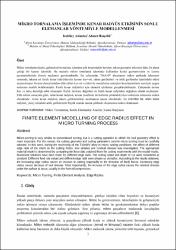| dc.contributor.author | Hasçelik, Ahmet | |
| dc.contributor.author | Aslantaş, Kubilay | |
| dc.date.accessioned | 2020-01-13T11:15:26Z | |
| dc.date.available | 2020-01-13T11:15:26Z | |
| dc.date.issued | Kasım 2018 | en_US |
| dc.identifier.citation | Aslantaş, K., Hasçelik, A. (2018). Mikro Tornalama İşleminde Kenar Radyus Etkisinin Sonlu Elemanlar Yöntemiyle Modellenmesi. 9. Uluslararası Talaşlı İmalat Sempozyumu, Antalya, 8-10 Kasım. | en_US |
| dc.identifier.uri | https://www.utis.tc/ | |
| dc.identifier.uri | https://hdl.handle.net/11630/8068 | |
| dc.description.abstract | Mikro tornalama işlemi, geleneksel tornalama işlemine çok benzemekle beraber, takım geometri etkisinin daha ön plana çıktığı bir kesme işlemidir. Bu nedenle mikro tornalama işleminde kullanılan kesici geometrisinin ve kesme parametrelerinin özenle seçilmesi gerekmektedir. Bu çalışmada, Ti6Al4V alaşımının mikro şartlarda işlenmesi sırasında, takıma ait farklı kenar radyüslerinin kesme kuvveti, takım gerilmeleri ve artık gerilmeler üzerindeki etkisi araştırılmıştır. Kesme deneylerinden elde edilen kuvvet verileri ile modelleme sonuçları karşılaştırılmak suretiyle uygun malzeme modeli belirlenmiştir. Farklı kenar radyüsleri için nümerik çözümler gerçekleştirilmiştir. Çalışmada kesme hızı ve talaş derinliği sabit alınmıştır. Farklı ilerleme değerleri ile farklı kenar radyüsleri değişken olarak seçilmiştir. Elde edilen sonuçlara göre, artan kenar radyüsü, kesme (özellikle de ilerleme yönündeki) kuvvetlerinin artmasına neden olmaktadır. Artan kenar radyüsü, takım gerilmelerinin azalmasına neden olmaktadır. En önemlisi ise; artan kenar radyüsü, yüzey altındaki artık gerilmelerin büyük oranda basma şeklinde oluşmasına neden olmaktadır. | en_US |
| dc.description.abstract | Micro-turning is very similar to conventional turning, but is a cutting operation in which the tool geometry effect is more important. For this reason, the cutting geometry and cutting parameters used in micro turning must be carefully selected. In this work, during the machining of the Ti6Al4V alloy in micro cutting conditions, the effect of different edge radii of the insert on the cutting forces, tool stresses and residual stresses was investigated. The appropriate material model is determined by comparing the force data obtained from the cutting experiments with the model results. Numerical solutions have been made for different edge radii. The cutting speed and depth of cut were considered as constant. Different feed rate values and different edge radii were chosen as variables. According to the results obtained, the increasing edge radius causes an increase in cutting (especially in the direction of feed) forces. Increasing edge radius causes decrease of tool stresses. Most importantly, the increase of the edge radius causes the residual stresses under the surface to occur, usually in the form of compression. | en_US |
| dc.language.iso | tur | en_US |
| dc.publisher | UTIS 2018 | en_US |
| dc.rights | info:eu-repo/semantics/openAccess | en_US |
| dc.subject | Mikro Tornalama | en_US |
| dc.subject | Sonlu Elemanlar Analizi | en_US |
| dc.subject | Kenar Radyüsü | en_US |
| dc.subject | Micro Turning | en_US |
| dc.subject | Finite Element Analysis | en_US |
| dc.subject | Edge Radius | en_US |
| dc.title | Mikro tornalama işleminde kenar radyüs etkisinin sonlu elemanlar yöntemiyle modellenmesi | en_US |
| dc.title.alternative | Finite element modelling of edge radius effect in micro turning process | en_US |
| dc.type | conferenceObject | en_US |
| dc.relation.journal | Uluslararası Talaşlı İmalat Sempozyumu (UTIS 2018) | en_US |
| dc.department | İscehisar Meslek Yüksekokulu | en_US |
| dc.authorid | 0000-0002-4615-0640 | en_US |
| dc.identifier.volume | 9th INTERNATIONAL CONGRESS ON MACHINING | en_US |
| dc.identifier.startpage | 37 | en_US |
| dc.identifier.endpage | 43 | en_US |
| dc.identifier.issue | 9. | en_US |
| dc.relation.publicationcategory | Konferans Öğesi - Uluslararası - Kurum Öğretim Elemanı | en_US |
| dc.contributor.institutionauthor | Hasçeli̇k, Ahmet | |
| dc.contributor.institutionauthor | Aslantaş, Kubilay | |



















